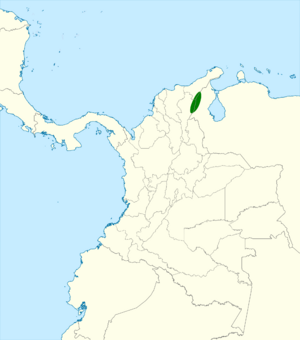Black-fronted brushfinch facts for kids
Quick facts for kids Black-fronted brushfinch |
|
|---|---|
 |
|
| Conservation status | |
| Scientific classification | |
| Genus: |
Atlapetes
|
| Species: |
nigrifrons
|
 |
|
The black-fronted brushfinch (Atlapetes nigrifrons) is a small, colorful bird. It belongs to the family of New World sparrows. You can find this bird only in a special mountain range. This area is called the Perijá Mountains. It is located on the border between northern Colombia and northwestern Venezuela.
Contents
About Its Name and Family
Scientists often study how different animals are related. For a long time, some experts thought the black-fronted brushfinch was a type of yellow-breasted brushfinch. They called it a "subspecies."
However, other bird experts now think it is its own unique species. These groups include the International Ornithological Congress (IOC). This means they believe it is different enough to be a separate kind of bird.
What Does a Black-fronted Brushfinch Look Like?
This bird is about 17 centimeters (6.7 inches) long. That's about the size of a small ruler.
- Its back and upper parts are a dark gray color.
- Its belly and chest are bright yellow.
- Its wings and tail are dark.
- The front of its head, near its beak, is black.
- The sides of its face are also black.
- The top of its head, called the crown, is a reddish-orange color. This color also goes down to the back of its neck.
Young black-fronted brushfinches look similar to the adults. But they do not have the reddish-orange crown.
Where Does the Black-fronted Brushfinch Live?
This bird lives only in one specific place. This place is the Serranía de Perijá mountain range. These mountains are on the border between northern Colombia and western Venezuela.
It likes to live in humid mountain forests. You can find it at elevations between 1,100 and 2,850 meters (3,600 to 9,350 feet). That's very high up! It prefers places with lots of shrubs. It also likes forests that are growing back after being cut down. This bird seems to be okay living in areas that have been changed by people.
How Does It Live?
Scientists are still learning about the black-fronted brushfinch. They don't know much about what it eats. They also don't know exactly how it finds its food.
However, they believe it acts like the yellow-breasted brushfinch. That bird usually looks for food on the ground. But it also finds food in trees. It often forages in pairs or small groups. It rarely joins other types of birds when looking for food.
Not much is known about how it raises its young. People have seen adult birds ready to breed between January and June. Young birds have been seen in August.
Is the Black-fronted Brushfinch in Danger?
The black-fronted brushfinch lives in a very small area. It is hard for scientists to get to these mountains. Because of this, we don't know how many of these birds there are.
The area where it lives has lost many trees. This is called deforestation. We don't know how this affects the bird. But it seems to be able to live in places where the forest has been disturbed.
The IUCN (International Union for Conservation of Nature) keeps track of animals. They say the black-fronted brushfinch is a species of "least concern." This means it is not currently in danger of disappearing.


